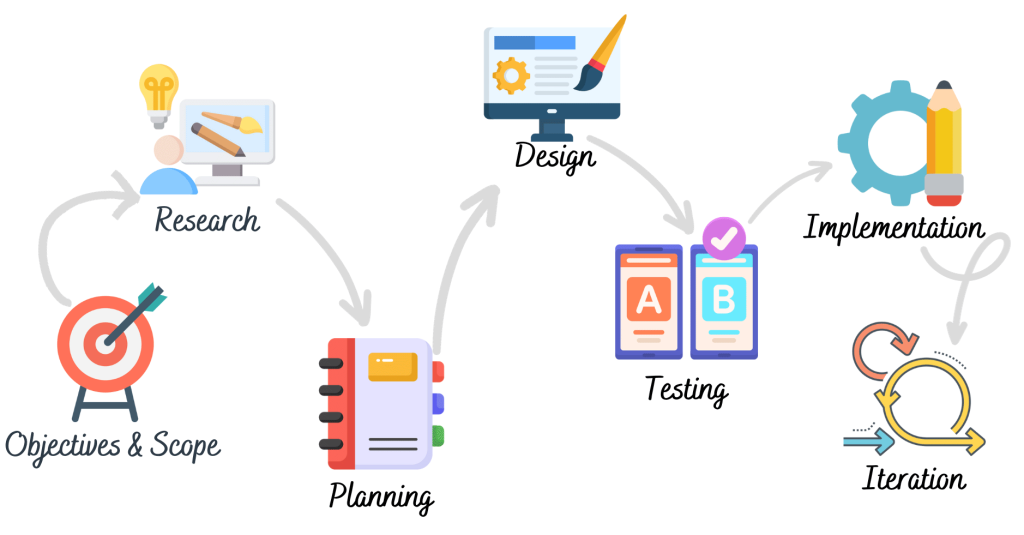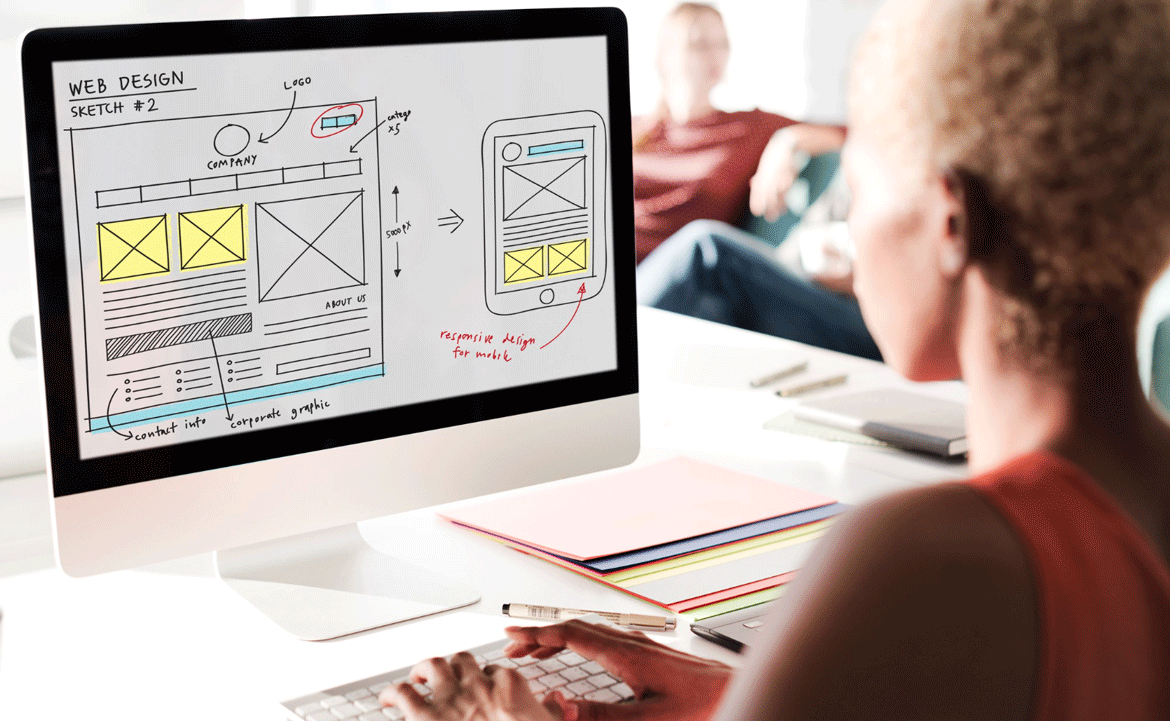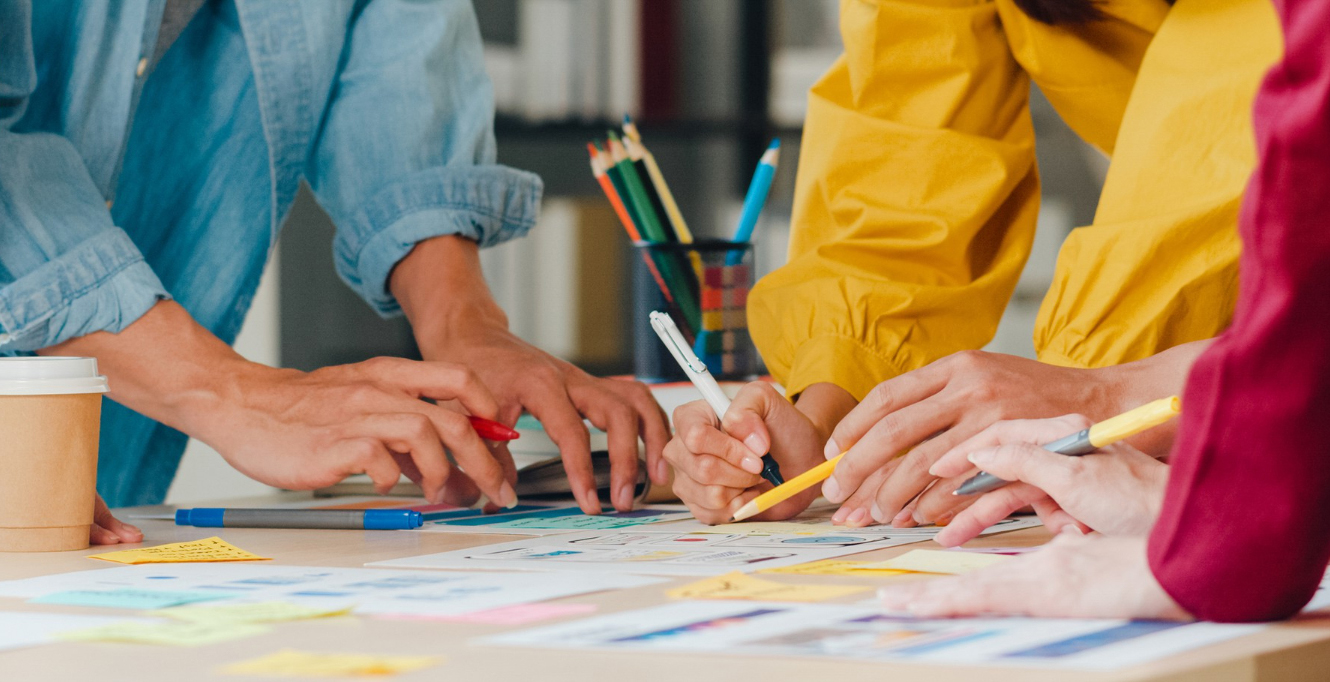User Experience (UX) design is a strategic discipline focused on optimizing how users interact with digital interfaces. It revolves around enhancing user satisfaction by elevating the usability, accessibility, and overall enjoyment of the digital experience. At its essence, UX design seeks to seamlessly integrate technology with human needs, creating interfaces that are not just functional but also attractive.
This article will delve into the intricacies of the UX design process exploring its stages to empower your understanding of this critical facet of digital innovation.
Table of Contents
- What is the UX Design Process?
- Why is the UX Design Process Important?
- The 7 Steps UX Design Process
- Step 1: Define Objectives and Scope
- Step 2: Research
- Step 3: Planning and Strategy
- Step 4: Design
- Step 5: Testing
- Step 6: Implementation
- Step 7: Iteration
- Summary
- Start the UX Design Process with IT Creative Labs
What is the UX Design Process?
The UX design process is a systematic approach that guides the creation and enhancement of user experiences within a digital product or service.
It is a structured series of steps, methodologies, and activities that UX designers follow to ensure that the end result aligns with user needs, business objectives, and industry standards. The process is iterative, allowing for continuous refinement based on user feedback and changing requirements.
Why is the UX Design Process Important?
Establishing a standardized UX design process is a strategic imperative for companies. This structured approach not only ensures the creation of products that align with user expectations but also contributes significantly to the overall success of a business.
Here are compelling reasons why companies prioritize and standardize a UX design cycle:
- User-centric focus: Aligns products with user needs, behaviors, and preferences.
- Enhanced usability: Ensures digital interfaces are functional, easy to use, and enjoyable.
- Reduced development costs: Identifies and addresses usability issues early, minimizing rework.
- Competitive advantage: Delivers superior user experiences, setting products apart.
- Increased user engagement: Encourages user interaction through intuitive and enjoyable experiences.
- Alignment with business goals: Connects design decisions with overarching business objectives.
- Positive impact on KPIs: Influences key performance indicators like user satisfaction and conversion rates.
The 7 Steps UX Design Process
The UX design process unfolds across 7 distinct stages:

Step 1: Define Objectives and Scope
During the initial stage of defining objectives and scope in the UX design process, the primary focus is on establishing a clear and comprehensive understanding of the project. This involves clarifying the overarching goals that the design process aims to achieve. By articulating these goals, the team ensures a shared vision and purpose for the project.
Simultaneously, the team defines the scope of the project, outlining its boundaries, features, and limitations. This step is crucial in providing a structured framework that sets the parameters for the design process. It helps in managing expectations and preventing scope creep as the project unfolds.
An equally important aspect of this stage is aligning stakeholders. Effective communication and collaboration among designers, developers, clients, and other key stakeholders are essential to ensure that everyone shares a unified understanding of the project’s purpose and objectives.
Step 2: Research
The first phase of the UX design process is research, a crucial step that lays the foundation for a user-centric approach. This stage involves various aspects:
- User research: Delve into user behaviors and needs, shaping design decisions with real insights.
- Methods and techniques: Employ diverse research methods like surveys and interviews for a holistic understanding.
- Creating user personas: Bring data to life by crafting personas, representing various user segments.
- Competitor analysis: Strategically analyze rivals to uncover opportunities for differentiation.
Step 3: Planning and Strategy
As the UX design process progresses, the next crucial stage involves meticulous planning and strategic considerations. This phase lays the groundwork for a seamless and purposeful user experience, encompassing:
- Defining project scope: Clearly outline the goals, features, and limitations of the project. This establishes the boundaries and sets realistic expectations for the design process.
- Setting design goals and objectives: Establish clear and measurable design goals that align with overarching business objectives. This ensures that the design decisions contribute to the success of the project.
- Creating user journeys and information architecture: Map out the user’s path through the digital interface, identifying key touchpoints and interactions. Simultaneously, craft an information architecture that organizes content for optimal user understanding and navigation.
In this phase, the focus is on creating a solid foundation that aligns design decisions with both user needs and business goals.
Step 4: Design
Moving forward in the UX design process, the design phase takes center stage. This stage involves translating strategic plans into tangible and visually engaging elements.
Within this creative realm, the following key components come to life:
- Wireframing: Craft the skeletal structure of the interface, mapping out its functionality. Think of it as the blueprint for the design.
- Low-fidelity vs. high-fidelity wireframes: Decide on the level of detail needed—low-fidelity for basics, high-fidelity for intricate design elements.
- Prototyping: Bring the design to life with interactive models, offering a tangible feel for the user experience.
- Interactive prototypes: Elevate the experience with dynamic simulations, making the prototype more realistic and engaging.
- Visual design: Infuse aesthetics into the design—playing with color, typography, and imagery to create a visually stunning interface.
- Importance of consistency: Emphasize uniformity in design elements for a cohesive and intuitive user experience.
- Color, typography, and imagery: Dive into the specifics of the visual identity—choosing color schemes, typography, and imagery that resonate with the brand and users.
Step 5: Testing
Now that the design has taken shape, it’s time to ensure its effectiveness through rigorous testing. Usability testing is a pivotal phase in the UX design process, offering invaluable insights and playing a crucial role in the success of a digital product.
The usability testing stage involves:
- Conducting tests: Put the product in the hands of real users to observe how they interact. This uncovers any potential issues and gathers valuable feedback.
- Analysis and iteration: Analyze the test results and iterate on the design based on user feedback. This iterative process refines the interface for optimal user experience.
Step 6: Implementation
With a refined and user-approved design in hand, it’s time to transition from theory to reality. The implementation step involves:
- Development: Bring the design to life through coding and programming, turning visual concepts into functional elements.
- Collaboration: Foster collaboration between design and development teams, ensuring a seamless transition from design to implementation.
- Quality assurance: Conduct rigorous testing to ensure that the implemented design functions as intended, identifying and addressing any potential bugs or issues.
The implementation phase is where the carefully crafted design becomes a tangible, interactive reality. It is the bridge between creative vision and a functional, user-friendly product.
Step 7: Iteration
In the Iteration phase, the design undergoes refinement based on insights gathered from user testing and feedback. This phase involves:
- Continuous testing and evaluation.
- Data-informed adjustments.
- Fine-tuning design elements.
- Optimizing for performance.
The Iteration phase is a dynamic and ongoing cycle, allowing designers to respond to user needs and evolving project requirements. It emphasizes continuous improvement, ensuring that the final design reflects the most refined and user-centric version possible. This iterative approach is fundamental to the agile and responsive nature of successful UX design.
Summary

In summary, the UX design process is a carefully organized process comprising key stages. It begins with defining clear objectives and project scope, setting the strategic foundation. The research phase follows, delving into user behaviors, needs, and competitive landscapes.
Subsequently, the design phase transforms insights into visual concepts, emphasizing consistency and aesthetic appeal. Usability testing validates the design, leading to the implementation phase, where the digital product comes to life.
The iterative process ensures adaptability and responsiveness to user feedback, resulting in an ever-evolving and user-centric design.
Start the UX Design Process with IT Creative Labs
Choosing IT Creative Labs ensures a comprehensive and client-centric approach to UX design. Our experienced team combines creativity with strategic thinking, delivering user experiences that resonate.
With cross-disciplinary expertise, we foster collaboration and provide innovative solutions that stand out in the digital landscape.
Embracing an iterative and agile process, we continuously refine designs based on feedback and data, ensuring the success of your digital ventures.




